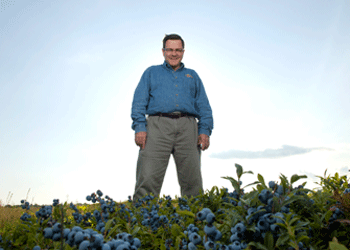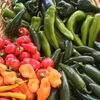Selling the blues | For more than 130 years, blueberries have been big business for Milbridge's Jasper Wyman & Son
First, here are a few things the world has lately discovered about wild blueberries: They contain more antioxidants than any other fruit or vegetable, meaning they could help protect against cancer, heart disease, Alzheimer’s and other age-related problems. They’re high in iron. They help relieve incontinence and abdominal pain. And they’re one of the favorite anti-aging foods of Oprah Winfrey’s health guru Dr. Mehmet Oz, who recently said they “lead the charge” among good-for-you grub.
All this means blueberries — and their particularly healthful strain, wild blueberries — are riding a baby-boomer fueled health craze straight to the bank. Since the mid-1990s, when the word “antioxidants” first entered the American lexicon, the U.S. Department of Agriculture reports per-capita consumption of fresh blueberries nearly doubled to 8.96 ounces in 2006, the most recent data available. The value of fresh, frozen or processed wild and cultivated blueberries in the United States was nearly $498 million last year, and Maine, the only state able to grow wild blueberries, last year harvested a crop valued at $83.3 million, according to the Maine Department of Agriculture. Countries like China, Germany and Japan, where blueberries are called “vision fruit” because they are believed to relieve eye strain, are importing millions of pounds of wild blueberries every year. Blue, it appears, is the new green, and that’s great news for Jasper Wyman & Son of Milbridge, the second-largest wild blueberry processor in the world.
Every August, Wyman harvests its roughly 10,000 acres of blueberry fields along the coast of Down East Maine and in the Canadian Maritimes. It’s a big job, requiring 130 year-round employees and some 500 seasonal workers, the majority of whom are migrants. From early August through Labor Day, Wyman’s two processing factories in DeBlois and Cherryfield sift, sort, rinse, and box up to 1.5 million pounds of blueberries a day to satisfy customers like General Mills, Sysco, Sara Lee and Wal-Mart.
“During this month, I’ll come out every day, for one reason or another,” says Wyman President and CEO Ed Flanagan. Flanagan, who lives in Boxford, Mass., usually works from an office just outside of Boston. But during the harvest he works in Milbridge and stays in Maine. And in September, when Wyman’s Canadian fields are ready to be picked, Flanagan will live and work from the town of Morell on Prince Edward Island. It’s the kind of lifestyle that was exciting when Flanagan was promoted from executive vice president of sales and marketing to president and CEO in 1995. But now, at age 57, the time away from home has lately been wearing on him and stressing his wife, Jane.
Flanagan, dressed in jeans, a Wyman parka and worn brown leather shoes, drives his pristine BMW minivan along Route One in Cherryfield, between acres of flat fields rendered a dull emerald by an overcast sky. These are the barrens, one of only a handful of spots in the world with the right mix of pine trees and salty soil for wild blueberries to grow.
Flanagan turns the van onto a narrow dirt road dividing one of the fields, shuts off the engine and climbs out to examine the crop. The fields are cool and silent, the harvest postponed because of days of drenching rain. Across the street in what Flanagan calls the “migrant compound,” a handful of idle workers wander the grounds, occasionally peering across the street at acres of unrealized income. “See, some of these are very small,” he says, squatting to gather a cluster of blueberries in his hand. Most of the fruit is a rich blue and about a third of the size of a cultivated blueberry, but some of the berries in Flanagan’s hand resemble white peppercorns. These shrunken blueberries are desperate for enough sun to mature. Even worse, the rain has saturated the good berries, which means their skins are more likely to split during freezing. Splits don’t affect the flavor, but Japan — Wyman’s largest importer — won’t buy imperfect berries.
“We need just a couple of sunny days,” Flanagan says. “I heard the rest of the week is going to be sunny.”
A “bright spot”
Flanagan says wild blueberry sales, as well as the processing of raspberries and strawberries from Chile, generate upwards of $70 million annually for the company, and that Wyman processes between 35% and 40% of the total Maine wild blueberry crop. In early August, Wyman completed a $10 million addition to its DeBlois processing plant. The company can now process an additional one to two million pounds of blueberries a day, for a total of 50 million pounds a season. Wyman, like many blueberry growers, is also converting to mechanical harvesting and has halved over the last decade the number of seasonal workers it needs.
The problem is where to put all the fruit. Flanagan says robust harvests in recent years and the increased demand for blueberries thanks to the advertised health benefits mean Wyman still can’t store all of its frozen crop. This year it will have to store millions of pounds of blueberries in subcontracted storage to meet the annual demand of 50 million pounds.
Experts estimate there are between 500 and 770 blueberry growers and processors in the state, though the majority of the harvest and revenue comes from the state’s two largest growers, Canadian-owned Cherryfield Foods, based in Cherryfield, and Wyman. Some 60% of Maine growers are located in Washington County.
“Obviously, it’s an important part of the economy here, for the blueberry growers, for the rakers, for the businesses that serve the rakers,” says Jon Reisman, associate professor of economics and public policy at the University of Maine at Machias. “It’s one of the few bright spots in the Washington County economy.”
By 1993, when Flanagan joined the company, Wyman generated what Flanagan considers a decent annual revenue of between $10 million and $15 million selling blueberries as ingredients for pastry and muffin mixes. But Flanagan, a sales and marketing expert who had worked at Boston dairy company H.P. Hood, saw the potential to boost Wyman’s sales significantly.
He added sales representatives to target retail clients like supermarkets and food service clients like Sysco. “We’re trying to get more into retail,” says Elizabeth Doudoumopoulos, vice chairwoman at Wyman and Jasper Wyman’s granddaughter, of the new strategy launched in the 1990s. “We let the retail slip when freezing came in [during the 1950s] and we finally got back into the retail with frozen blueberries in the bag in the grocery store and the blueberry juice.”
Flanagan also expanded efforts to sell abroad, particularly in European and Japanese markets. The company has since doubled its number of full-time employees and the size of its annual crop is now second in the world only to Cherryfield Foods.
The next steps
Jasper Wyman, an entrepreneur who founded Jasper Wyman & Son in 1874, might be shocked by the extent of the operation today, not least because Wyman wasn’t thinking blueberries when he founded the company. Wyman launched Jasper Wyman & Son as a lobster canning company, and added blueberries two years later after a law banning blueberry picking on private land suddenly made the little fruits a commodity. Today, the company is owned by seven third- and fourth-generation Wymans who sit on its board of directors. Flanagan describes the Wymans as “good people” running “an old-fashioned Yankee company.” The Wyman descendents, none of whom have the Wyman last name, are tight-lipped about exact revenue figures and only invest in the company when profits allow. Only one of the seven lives year-round in Maine, Jasper Wyman’s great-granddaughter Elizabeth Lane of Eliot. The highest-ranking family member, Elizabeth Doudoumopoulos, splits her time between homes in Winter Harbor and Washington D.C. Doudoumopoulos, 81, says the challenges the company faces have been the same for decades and will likely remain the same for the foreseeable future: supply and weather.
“A lot of Wyman’s challenges are environmental,” says David Yarborough, a blueberry specialist at the University of Maine Cooperative Extension. Nature’s roadblocks include the mysterious Colony Collapse Disorder affecting honeybees, or what Flanagan calls “one of those sort of doomsday scenarios that keeps me up at night.” Applying pesticides without prompting lawsuits can also be difficult (Wyman in 2005 agreed to stop aerial spraying after a coalition of environmental groups including Environment Maine and the Toxics Action Center filed an intent to sue), as can finding the water and securing the permits to irrigate fields (Wyman, a notoriously cautious company, has been slower to irrigate than some other growers, and now irrigates only about half of its fields). Global warming also has become a real concern. Canadian-based growers have lately become stronger competitors because the spring frosts that once regularly devastated wild blueberry crops in the Maritimes now occur half as often, according to the Boston Globe.
But perhaps Wyman’s biggest balancing act is as much a people problem as a natural one — harvesting just enough blueberries for its needs, but not so many it gluts the market and sends prices plummeting, as happened in 2002 when wild blueberry growers made $0.25 per pound at market, a 17-year low, according to the New York Times, and only a fraction of the $1 per pound average the Maine Department of Agriculture reports was last year’s norm. “If you haven’t sold a sufficient amount of your inventory, then you won’t have enough to bring in your next crop,” says Flanagan. “So it can be nail-biter at times.”
A couple of years ago, Wyman upgraded its website. It’s now sleek and user-friendly, with plenty of information on why consumers should “go blue” with their diet, as well as details on their new sustainability bent. It also includes an “About Wyman” video with sweeping aerial footage of lush Wyman land set to inspirational orchestral music. Near the end of the video, Flanagan appears at the conference table in his Milbridge office. He’s talking to the camera, his reddish-brown hair neatly combed to the side, his shoulders slightly hunched, in a blue shirt with the Wyman logo over the breast. “Thank you for taking these few minutes to learn about Wyman’s,” he says matter-of-factly, reading from a script written for clients and potential customers all over the world. “The food industry is remarkable across nearly every measure, and so is our business. No matter what the class of trade or the country that we are exporting to, all of our customers are looking for higher quality and lower cost.” Flanagan pauses and then launches into the crux of his speech — a Japanese quote referring to that country’s kaizen philosophy of continuous improvement. Kaizen, he says, “simply means that we’ve got to do everything we can to grow our business.”
Sara Donnelly, Mainebiz managing editor, can be reached at sdonnelly@mainebiz.biz.












Comments